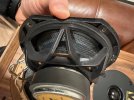I don't know why you would remotely compare those two. Here is the Denton again:
Bass starts to roll off at 100 Hz and by 2 kHz, it already has had two resonances with one major one around 700 Hz. It also has severe directivity error around 2 to 3 kHz. Here is the M105:
See how it has ruler flat bass response down to 70 Hz. That flat response sports almost no resonances or deviations up to 2.5 kHz. While it also has a bit of directivity error, it is much less severe due to deployment of waveguide.
Everything we know about science of speaker preference says the M105 is superior to Denon 80 and by a mile. I mean look at the predicted in-room response:
Here is the Denton 80:
No way, no how you are going to get the M105 PIR out of Denton by putting a grill on it. The response has the wrong slope on top of pronounced resonances.
You want to tell me that I should have had a bad experience given this data and made it up that the M105 sounded great and Denton didn't??? If so, you should stop reading my reviews there since you are throwing out every core idea behind the predictive power of measurements.






